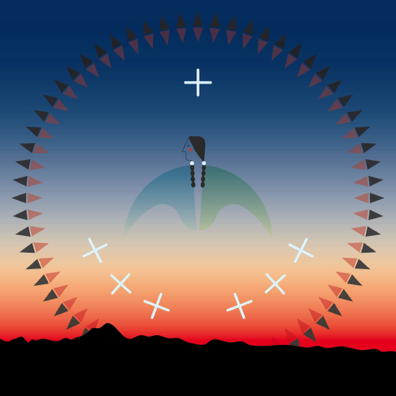
. . . and innovative projects . . .
The background of the Tapun Sa Win logo is the western sky after sunset, that liminal period between daytime and nighttime. The dark silhouette at the bottom is an actual reproduction of He Sapa looking west from SD Highway 44 near where it crosses the Cheyenne River. Its highest point is Black Elk Peak. In the center of the logo is a representation of Tapun Sa Win, the Lakota woman who married a star and went to live with him in the sky. She is looking to her right, thereby implying a right-to-left movement in the logo that is typical of traditional Lakota art. The green and blue colors of her cape represent the earth and sky, respectively. Beneath her are two sets of three stars equally spaced so that there is a space for a seventh central star that would unify them. Its absence represents the hole in the sky mentioned in the narrative through which Tapun Sa Win saw her relatives on the earth below, and through which she descended in an effort to rejoin them. Unfortunately her rope was not long enough to reach earth, and she ended up falling to her death. Some claim that place she fell is Pe Sla in the heart of He Sapa. From our viewpoint of the He Sapa silhouette, Pe Sla is directly beneath the gap between the central stars. Above Tapun Sa Win is a star representing her husband who upon learning of her death sat down and hasn’t moved since. He is called Wicahpi Owanjila, the Star That Doesn’t Move. He and the other six stars represent all of Lakota cosmology and culture entailed by the number seven: the seven Pte families who emerged onto this earth at Wasun Niya; the seven sacred ceremonies foretold by Ptehincala Win; the Oceti Sakowin; the seven Lakota oyates; the seven Lakota nations today. There are seven stars in the star cluster Wicakiyuhapi, the Big Dipper, whose two end stars point to Wicahpi Owanjila. And Wicahpi Owanjila is the star at the end of the handle of the Little Dipper, which also has seven stars. Encircling the logo is a ring of opposing triangles reminiscent of a quintessential Lakota pattern called the black war bonnet design. The shape of the negative space between the triangles recall Lakota tipis, the lodges of the people.

Logo